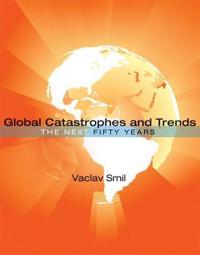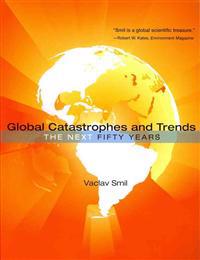Energy at the Crossroads: Global Perspectives and Uncertainties (Pocket)
avSmil, Vaclav
ISBN: 9780262693240 - UTGIVEN: 2005-03-15Winner in the cover category of the AIGA 50 Books/50 Covers of 2003 competition presented by the American Institute of Graphic ArtsIn "Energy at the Crossroads," Vaclav Smil considers the twenty-first century's crucial question: how to reconcile the modern world's unceasing demand for energy with th[...]
Creating the Twentieth Century (Inbunden)
avVaclav Smil
ISBN: 9780195168747 - UTGIVEN: 2005-09The period between 1867 and 1914 remains the greatest watershed in human history since the emergence of settled agricultural societies: the time when an expansive civilization based on synergy of fuels, science, and technical innovation was born. At its beginnings in the 1870s were dynamite, the tel[...]
Transforming the Twentieth Century (Inbunden)
avVaclav Smil
ISBN: 9780195168754 - UTGIVEN: 2006-04This inquiry into the technical advances that shaped the 20th century follows the evolutions of all the principal innovations introduced before 1913 (as detailed in the first volume) as well as the origins and elaborations of all fundamental 20th century advances. The history of the 20th century is [...]
Japan's Dietary Transition and Its Impacts (Inbunden)
avVaclav Smil, Kazuhiko Kobayashi
ISBN: 9780262017824 - UTGIVEN: 201209In a little more than a century, the Japanese diet has undergone a dramatic transformation. In 1900, a plant-based, near-subsistence diet was prevalent, with virtually no consumption of animal protein. By the beginning of the twenty-first century, Japan's consumption of meat, fish, and dairy had inc[...]
Harvesting the Biosphere (Inbunden)
avVaclav Smil
ISBN: 9780262018562 - UTGIVEN: 201302The biosphere -- the Earth's thin layer of life -- dates from nearly four billion years ago, when the first simple organisms appeared. Many species have exerted enormous influence on the biosphere's character and productivity, but none has transformed the Earth in so many ways and on such a scale as[...]
Made in the USA (Inbunden)
avVaclav Smil
ISBN: 9780262019385 - UTGIVEN: 2013-09"There is probably no other writer whose books I anticipate with more enthusiasm than Vaclav Smil. He brings remarkable insight to every topic he examines, combining his vast knowledge of science and energy, history and business to address some of the most pressing issues we face today. So I'm pleas[...]
Power Density (Inbunden)
avVaclav Smil
ISBN: 9780262029148 - UTGIVEN: 2015-05In this book, Vaclav Smil argues that power density is a key determinant of the nature and dynamics of energy systems. Any understanding of complex energy systems must rely on quantitative measures of many fundamental variables. Power density -- the rate of energy flux per unit of area -- is an impo[...]
Energies: An Illustrated Guide to the Biosphere and Civilization (Inbunden)
avVaclav Smil
ISBN: 9780262194105 - UTGIVEN: 1999-01-04Energy at the Crossroads (Inbunden)
avVaclav Smil
ISBN: 9780262194921 - UTGIVEN: 2003-11In Energy at the Crossroads, Vaclav Smil considers the twenty-first century's crucial question: how to reconcile the modern world's unceasing demand for energy with the absolute necessity to preserve the integrity of the biosphere. With this book he offers a comprehensive, accessible guide to today'[...]
Global Catastrophes and Trends (Inbunden)
avVaclav Smil
ISBN: 9780262195867 - UTGIVEN: 200809Fundamental change occurs most often in one of two ways: as a "fatal discontinuity," a sudden catastrophic event that is potentially world changing, or as a persistent, gradual trend. Global catastrophes include volcanic eruptions, viral pandemics, wars, and large-scale terrorist attacks; trends are[...]
Why America is Not a New Rome (Inbunden)
avVaclav Smil
ISBN: 9780262195935 - UTGIVEN: 2010-01America's post--Cold War strategic dominance and its pre-recession affluence inspired pundits to make celebratory comparisons to ancient Rome at its most powerful. Now, with America no longer perceived as invulnerable, engaged in protracted fighting in Iraq and Afghanistan, and suffering the worst e[...]
Global Catastrophes and Trends (Häftad)
avVaclav Smil
ISBN: 9780262518222 - UTGIVEN: 201210Fundamental change occurs most often in one of two ways: as a "fatal discontinuity," a sudden catastrophic event that is potentially world changing, or as a persistent, gradual trend. Global catastrophes include volcanic eruptions, viral pandemics, wars, and large-scale terrorist attacks; trends are[...]
Prime Movers of Globalization (Häftad)
avVaclav Smil
ISBN: 9780262518765 - UTGIVEN: 201302The many books on globalization published over the past few years range from claims that the world is flat to an unlikely rehabilitation of Genghis Khan as a pioneer of global commerce. Missing from these accounts is a consideration of the technologies behind the creation of the globalized economy. [...]
Why America is Not a New Rome (Häftad)
avVaclav Smil
ISBN: 9780262526852 - UTGIVEN: 2014-10America's post--Cold War strategic dominance and its pre-recession affluence inspired pundits to make celebratory comparisons to ancient Rome at its most powerful. Now, with America no longer perceived as invulnerable, engaged in protracted fighting in Iraq and Afghanistan, and suffering the worst e[...]
Energies: An Illustrated Guide to the Biosphere and Civilization (Övrig)
avVaclav Smil
ISBN: 9780262692359 - UTGIVEN: 2000-04-04Energy is the only universal currency. One of its many forms must be transformed into another in order for stars to shine, planets to rotate, living things to grow, and civilizations to evolve. Recognition of this universality was one of the great achievements of nineteenth-century science, yet even[...]
Feeding the World (Häftad)
avVaclav Smil
ISBN: 9780262692717 - UTGIVEN: 200110This book addresses the question of how we can best feed the ten billion or so people who will likely inhabit the Earth by the middle of the twenty-first century. He asks whether human ingenuity can produce enough food to support healthy and vigorous lives for all these people without irreparably da[...]
The Earth's Biosphere (Häftad)
avVaclav Smil
ISBN: 9780262692984 - UTGIVEN: 200312In his latest book, Vaclav Smil tells the story of the Earth?s biosphere from its origins to its near- and long-term future. He explains the workings of its parts and what is known about their interactions. With essay-like flair, he examines the biosphere?s physics, chemistry, biology, geology, ocea[...]
Enriching the Earth (Pocket)
avVaclav Smil
ISBN: 9780262693134 - UTGIVEN: 2004-04The industrial synthesis of ammonia from nitrogen and hydrogen has been of greater fundamental importance to the modern world than the invention of the airplane, nuclear energy, space flight, or television. The expansion of the world's population from 1.6 billion people in 1900 to today's six billio[...]
Energy In Nature And Society (Pocket)
avVaclav Smil
ISBN: 9780262693561 - UTGIVEN: 2008-02-01A comprehensive, systematic, analytically unified, and interdisciplinary treatment of energy in nature and society, from solar radiation and photosynthesis to our fossil fuelled civilization and its environmental consequences. This book explores not only planetary energetics and bioenergetics but al[...]
Energy Transitions (Inbunden)
avVaclav Smil
ISBN: 9780313381775 - UTGIVEN: 2010-05Energy transitions are fundamental processes behind the evolution of human societies: they both drive and are driven by technical, economic, and social changes. In a bold and provocative argument, Energy Transitions: History, Requirements, Prospects describes the history of modern society's dependen[...]
Energy Myths and Realities (Inbunden)
avVaclav Smil
ISBN: 9780844743288 - UTGIVEN: 201008There are many misconceptions about the future of global energy often presented as fact by the media, politicians, business leaders, activists, and even scientists-wasting time and money and hampering the development of progressive energy policies. Energy Myths and Realities: Bringing Science to the[...]
Should We Eat Meat? Evolution and Consequences of Modern Carnivory (Häftad)
avVaclav Smil
ISBN: 9781118278727 - UTGIVEN: 2013-05-31Natural Gas: A Primer for the 21st Century (Pocket)
avVaclav Smil
ISBN: 9781119012863 - UTGIVEN: 2015-07-31Making the Modern World: Materials and Dematerialization (Häftad)
avVaclav Smil
ISBN: 9781119942535 - UTGIVEN: 2013-11-30How much further should the affluent world push its material consumption? Does relative dematerialization lead to absolute decline in demand for materials? This title answers these and many other questions. It explores the costs of this dependence and the potential for substantial dematerialization [...]
Energy (Pocket)
avVaclav Smil
ISBN: 9781851684526 - UTGIVEN: 2006-06-30Reveals how every aspect of our existence is governed by one of the most important concepts in our universe.[...]
























